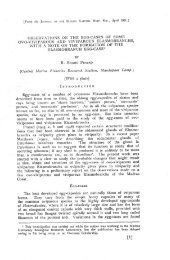PDF - Eprints@CMFRI
PDF - Eprints@CMFRI
PDF - Eprints@CMFRI
Create successful ePaper yourself
Turn your PDF publications into a flip-book with our unique Google optimized e-Paper software.
8 3<br />
Costae correspond to septa, major costae 2 to 3 mm high and thick at the periphery of the disc, low<br />
and thin at the centre. Costal teeth 2 to 3 mm high, pointed at the tip, larger ones bifurcated, 1 to 2 mm<br />
thick at the base. Two almost complete rings of ridges formed by coenenchymal deposition bridge all<br />
costae at the underside.<br />
PW 73606 is a dead coral piece covered with calcareous algae and with three attached small and very<br />
young Fungiae, which we put with a query to F. scruposa.<br />
Mate rial:<br />
Gulf of Aqaba: Basel PW 71305 (juv., Eilat, 40 m) ; 73 606 (? , juv., Fara 'un Isl.).<br />
orther R. S.: HLM EC 515 (Ras Abu Hagar).<br />
Di s t rib uti on : Red Sea; East Indies (v. d. HORST, 1921 ); Japan ; Great Barrier Reef.<br />
Rem ark s: The major distinctions between the present species and F. horrida are in the highly<br />
lacerated and irregular teeth and the better perforation at the undersurface of F. scruposa. More specimens<br />
are to be examined to ascertain the relationship of these two forms.<br />
Fungia<br />
Fungia horrida DANA , 1846<br />
(Pl ate 19, Figs. 5, 6)<br />
1846. DANA, 298; pI. 19/7 (Type locality: Fiji).<br />
1902. DOEDERlEIN. 122; pI. 14/ 1, lao<br />
1906. v. MARENZELLER. 89.<br />
1909. GARDINER. 267.<br />
1924, MATIHAI . 44; pis. 9 /2; 10/6.<br />
1925. BOSCHMA. 66; pI. 1214 . 6.<br />
1979. SCHUHMACHER, 2 10.<br />
1980, VERON & PICHON. 139; figs. 226- 230 (synonymy).<br />
1980. HEAD. 150. 452.<br />
field; 1909. GARDINER. 277; pis. 3313. 4; 3417.<br />
rnadagascariensis 1906a, VAUGHAN, 831 ; pis. 72; 73 ; 74/ 3.<br />
tKJlida 1879. KLUNZINGER 3, 62 : pI. 8/7,8 (non VE RRILL, 1864).<br />
The present specimens are either arched or flat. One of our speci mens (S LR 1226) is an attached stage.<br />
The adult specimens have prominent septal dentations characteristic of this species. A specimen from<br />
USN M (Wa 43 ), which we examined , is a circular flat disc with a greater diameter of 18 cm. Axial fossa<br />
only 3 cm long and 0.5 cm wide . It agrees to KLU ZINGER's description of F. valida (non VERRILL).<br />
There are 3 to 4 large teeth per cm length of septum.<br />
Material:<br />
Gulf of Aqaba: )erus. SLR 1226 (juv., Fara'un Isl.) ; 395 - 1 (Marsa Murach).<br />
T. Aviv NS 6160 (juv.) , 9294 (Eilat).<br />
Northern R. S.: USNM Wa 43 (Ghardaqa).<br />
HLM X2 : 2- 26 (?, juv., Guballsl.).<br />
Central R. S.: P. Sud . Sa 104 (Sanganeb R.).<br />
Dis t rib uti o n: Red Sea ; Madagascar; East Indies; Philippines; Great Barrier Reef; Fiji ; Tahiti .<br />
Rem a rk s: The difference between F. horrida and F. valida VERRILL (type locality: Zanzibar) is<br />
slight. According to DOEDERLEIN (J 902) KLUNZ INGER 's F. valida is only F. horrida and not conspecific<br />
with that of VERRI LL.<br />
The type of F. fieldi GARDINER ( 1909) in the Zoological Museum of Cambridge University is a disc·<br />
shaped coraUum with every fourth septum broader than the intervening ones. The costal spines are swollen,<br />
the larger ones are up to 7 mm high.<br />
The type of F. madagascariensis VAUGHAN (1906a) is USNM 21141, a very heavy specimen, which<br />
shows little variation from F. fieldi and F. valida.<br />
It appears to the present authors that all the species mentioned here are skeletal variants of one and<br />
the same species which should be called F. horrida.<br />
12 ZooiogiCI, 133
















